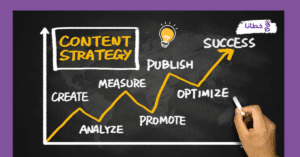table of contents
User experience (UX) is one of the critical factors affecting the success of any website. It’s not just about the user interface (UI) design; it also encompasses how visitors interact with the site and how easily they navigate it. In this article, we’ll explore some key strategies for improving user experience to increase conversion rates.
Key strategies to improve user experience to increase conversion rates
1- Focus on loading speed to improve user experience.
Loading speed is the first thing a visitor notices when they access your site. Make sure your site’s pages load quickly, as prolonged waiting can lead to lost visitors and increased bounce rates.
2- Responsive design leads to improved user experience.
Your website design should be responsive to all devices, whether desktop, smartphone, or tablet. This ensures a consistent user experience across all devices.
3- Improving navigation helps improve user experience.
Site navigation should be intuitive and easy to use. Use organized menus and clear links to help visitors quickly find what they’re looking for.
4- Attractive and useful content
Provide valuable content that answers visitors’ questions and solves their problems. Use subheadings, bullet points, and images to make your content more engaging and easier to read.
5- Use keywords strategically.
Choose keywords carefully and use them naturally in your content. This helps improve your site’s search ranking and attract more targeted visitors.
6- Data analysis and continuous improvement
Use web analytics tools to monitor visitor behavior and optimize your site based on the data. Run A/B tests to see which changes lead to increased conversion.
What are the best ways to improve site speed?
To improve your website speed, you can follow these methods:
- Get rid of unnecessary software: Remove software tools and add-ons that you don’t use to improve performance.
- Use a caching system: Enable cache systems such as Wp Super Cache to speed up page loading.
- Compress code: Use tools like Auto Optimize to compress code and pages.
- Site Speed Analysis: Use tools like GTMetrix to analyze and measure your site speed and identify issues.
- Improve server response: Reduce server response time to improve overall site performance.
- Resize images: Resize images on your site to reduce loading time.
By following these steps, you’ll be able to improve your site’s speed, enhance user experience, and increase conversion rates. Read more: 10 SEO Strategies for Your Website.
What is conversion rate optimization?
Conversion Rate Optimization (CRO) means improving the rate at which your website visitors take a specific action on your site based on what they search for on search engines. This process can vary depending on the type of website and your goals, such as:
1- Purchasing a product or service: If you run an online store or offer certain services, your conversion rate can be improved by optimizing your product or service pages, making them attractive and easy to understand, and providing clear information about the benefits, price, and purchasing methods.
2- Communication or Contact: In some cases, the next step may be to communicate with your website visitors, whether by filling out a contact form or making a phone call. Your conversion rate can be improved by simplifying this process and making it a deposit.
3- Download content: If you offer valuable content such as a guide or a free report, you can improve your conversion rate by optimizing your landing pages to highlight the value of the content and encourage downloading.
4- Newsletter Subscription: If you want to collect contact information from visitors to direct them later, you can improve your conversion rate by designing subscription forms conveniently and attractively.
You can improve your search engine conversion rate by implementing A/B tests to test small changes to your pages and measure how they impact conversion rates. This requires careful analysis and ongoing experimentation to identify the factors that positively or negatively impact conversion rates and take appropriate action to improve them.

The importance of measuring your website’s conversion rates on search engines to improve user experience.
Measuring your website’s conversion rates on search engines is vital to the success of any online marketing strategy. Here are some points that highlight the importance of this measurement:
- Improving user experience: Analyzing conversion rates can help you determine how to improve the user experience on your site, leading to improvements that attract and retain more visitors.
- Discover weaknesses: Measuring conversions can reveal problems with your site, such as weak landing pages or complex checkout processes, allowing you to improve them.
- Increase profits: Of course, the ultimate goal of any business website is to increase profits. High conversion rates mean more customers and therefore more revenue.
- Understanding visitor behavior: Measuring conversion rates helps you understand how visitors interact with your site and what elements grab their attention or drive them to convert.
- Improve ROI: By tracking conversion rates, you can identify the most effective strategies and improve the return on investment (ROI) of your marketing campaigns.
- Set goals and measure success: Measuring conversion rates helps you set clear goals for your site and evaluate how well you’re achieving those goals.
It is important to use the right web analytics tools to measure conversion rates and to analyze the data periodically to continually improve your strategies.
Some tips to improve user experience and increase conversion rates on your website:
- Encourage newsletter subscriptions: You can motivate visitors to subscribe to your newsletters by offering exclusive content or special discounts to subscribers.
- Optimize your calls to action (CTAs): Use clear, compelling phrases that urge visitors to take a specific action, such as “Buy now” or “Get the deal.”
- Segmented Emails: Send targeted emails based on user actions, such as abandoned cart reminders.
- Highlight recommendations about products or services: Use recommendations and reviews from past customers to build trust and encourage visitors to purchase.
- Reduce perceived risk for potential customers: Offer money-back guarantees or financial guarantees to reduce perceived risk and increase trust.
- Leverage social proof: Showcasing customer reviews and testimonials can increase trust and encourage visitors to take action.
- Responsive design: Make sure your site works well on all devices, making it easy for visitors to navigate and purchase from any device.
- Add social proof: Display customer testimonials, awards, and accreditations to enhance your site’s credibility.
Khutana Company and improving the user experience of your website
If you’re looking for a leading SEO and digital marketing company, you’ll find Khutana offers SEO and digital marketing services, relying on a select group of experts in this field. Don’t hesitate to contact us.
Suggestions for converting visitors into permanent customers to improve user experience and increase conversion rates.
Converting new visitors into repeat customers is a key goal for any e-commerce website. Here are some effective ways to achieve this:
- Effective communication: Use email and social media to connect with visitors and convert them into customers through personalized offers and content.
- Improve the purchasing process: Make the purchasing process simple and straightforward, and offer multiple payment options to make the process easier for customers.
- Loyalty and Rewards Programs: Develop loyalty programs that reward customers for repeat purchases and encourage them to stay with you.
- Analyze and continuously improve: Use analytics tools to understand visitor behavior and improve your site based on the collected data.
- Engaging and useful content: Provide content that meets visitors’ needs and questions, encouraging them to come back again.
- Special Offers and Discounts: Offer exclusive offers or discounts to new visitors to encourage them to purchase.
- Listen to customers: Collect feedback and comments from customers and use them to improve products and services.
- Provide an excellent user experience: Make sure your website is easy to use and offers a smooth and enjoyable user experience.
Implementing these methods strategically and consistently helps convert new visitors into repeat customers and build a loyal customer base. Improving user experience not only increases visitor satisfaction but also contributes to increased conversion rates and profits. By implementing the strategies mentioned above, you can enhance the user experience on your website and achieve better results.
Questions about the article Improving User Experience: Effective Strategies to Increase Conversion Rates 2025
What does it mean to enhance user experience?
User experience improvement refers to the process of enhancing the overall experience of users interacting with a digital platform, such as a website or app. This is achieved by improving elements such as design, usability, accessibility, and performance to provide a seamless and engaging interaction.
How can user experience be improved?
Understand their needs, preferences, and pain points to customize the user experience accordingly. Implement intuitive navigation: Design a clear and logical navigation structure that enables users to easily find what they need. Use descriptive labels and organize content hierarchically.
What is user experience flow?
A user experience flow is a diagram that depicts a user’s journey through your product, from the initial stage to the final interaction. You can create multiple user flows as part of a single project, given the multiple goals each user pursues.
What are user personas?
User personas are profiles that represent the wants and needs of a subset of your target audience. These personas provide an in-depth analysis of your ideal customer, their behavior patterns, goals, skills, attitudes, problems, and background information.
We respect and value your time... half an hour to grow your project
































